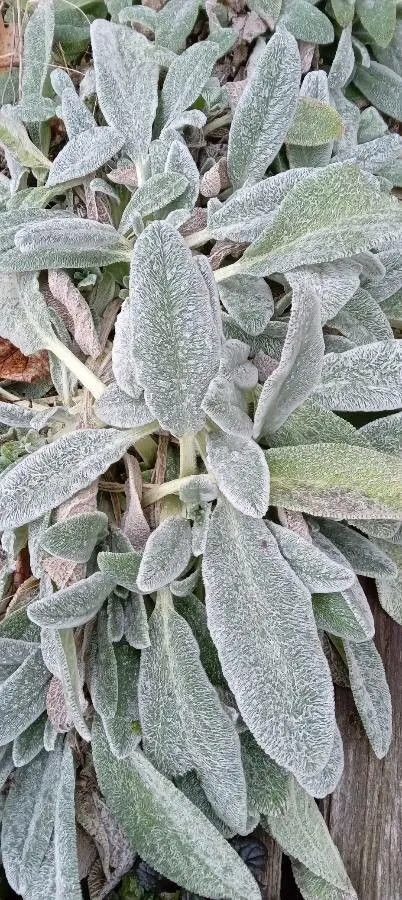
Author: K.Koch
Bibliography: Linnaea 21: 686 (1849)
Year: 1849
Status: accepted
Rank: species
Genus: Stachys
Vegetable: False
Observations: Krym, N. Türkiye to N. Iran
Lamb’s-ear, scientifically known as Stachys byzantina, is a distinctive and charming plant revered in horticulture for its unique foliage and easy care. Originally classified by the renowned botanist K.Koch in 1849 and documented in Linnaea, the plant has remained a favorite among garden enthusiasts and landscapers alike.
One of the most striking features of Lamb’s-ear is its dense, woolly leaves. These leaves, reminiscent of a lamb’s soft ear, are coated in tiny white hairs, giving the plant its signature silvery-gray appearance. This characteristic fuzz not only makes the plant visually appealing but also serves a functional purpose by reflecting sunlight and reducing water loss, making it quite drought-tolerant.
The natural habitat of Stachys byzantina spans from the Crimean Peninsula and northern Turkey to northern Iran. In these regions, the plant thrives in rocky, well-drained soils and under full sun, mimicking the conditions often found in rock gardens and xeriscaped areas. This geographical range highlights the plant’s adaptability to various environmental conditions, from temperate climates to more arid regions.
As a member of the Lamiaceae family, Lamb’s-ear shares a lineage with many aromatic herbs and essential landscape plants. Due to its relatively low-growing habit, typically forming a dense mat about 30 cm high, it serves well as ground cover. Additionally, it produces spikes of small, inconspicuous purplish-pink flowers during the summer months, which can add a subtle dash of color to gardens.
Lamb’s-ear is not only appreciated for its aesthetic appeal but also for its practical uses. Gardeners often employ it to outline garden paths or as a soft border plant. Its tactile, velvety leaves make it a favorite among children and contribute to sensory gardens where touch is as important as sight.
Caring for Stachys byzantina is relatively straightforward. The plant prefers full sun and well-drained soil. While it can tolerate dry conditions, regular watering will keep it looking its best, especially during prolonged dry spells. It is also resilient to pests and diseases, making it a low-maintenance option for those looking to add a touch of silvery softness to their garden spaces.
In summary, Stachys byzantina, or Lamb’s-ear, is a versatile, hardy plant with a visual and tactile appeal. Its cultural history, geographic origin, and practical utility in garden design make it a beloved fixture in many landscapes around the world.
Deu: byzantinischer ziest, woll-ziest, wolliger ziest
Eng: lamb’s-ear, lamb’s-ears, lamb’s-lugs, lamb’s-tails, lamb’s-tongue, woolly betony, woolly hedgenettle, woolly stachys, woolly hedge-nettle
Dan: lammeøre
Fra: epiaire laineuse, épiaire de byzance, épiaire laineuse, épiaire laineux
Hun: gyapjas tisztesfű, nyuszifül
Nob: lammeøre
Nno: lammeøyre
Swe: lammöron, nukkapähkämö, ullsyska
Fin: nukkapähkämö
Por: orelha-de-coelho, orelha-de-lebre, stachis
Nld: wollige andoorn
Cym: clust yr oen
En: Lamb’s-ear, Woolly hedgenettle, Lamb’s-ears, Lamb’s-lugs, Lamb’s-tails, Lamb’s-tongue, Woolly betony, Woolly stachys, Woolly hedge-nettle
Ca: Herba de sant Pelegrí
Da: Lammeøre
Nl: Wollige andoorn, Ezelsoor
Fi: Nukkapähkämö
Fr: Epiaire laineuse, Épiaire de Byzance, Épiaire laineuse, Épiaire laineux
De: Byzantinischer Ziest, Woll-Ziest, Wolliger Ziest
Hu: Gyapjas tisztesfű, Nyuszifül
It: Stregona candida
Nb: Lammeøre
Nn: Lammeøyre
Pt: Orelha-de-coelho, Orelha-de-lebre, Stachis
Sv: Lammöron, Nukkapähkämö, Ullsyska
Cy: Clust yr Oen
Taken May 31, 2020 by silvia (cc-by-sa)
Taken Sep 17, 2018 by Dieter Wagner (cc-by-sa)
Taken Sep 17, 2018 by Dieter Wagner (cc-by-sa)
Taken Dec 8, 2021 by India Barford (cc-by-sa)
Taken Nov 24, 2021 by Decobert Didier (cc-by-sa)
Taken May 19, 2018 by jose (cc-by-sa)
Taken Jun 4, 2018 by sunriz (cc-by-sa)
Taken May 30, 2019 by Wilhelm Rogmann (cc-by-sa)
Taken May 19, 2018 by jose (cc-by-sa)
Taken Sep 17, 2018 by Dieter Wagner (cc-by-sa)
Taken Jul 20, 2019 by Ivaylo Ivanov (cc-by-sa)
Taken Mar 24, 2021 by Schmidt Fernando da Luz (cc-by-sa)
Taken Dec 7, 2022 by Fabrice Rubio (cc-by-sa)
Taken Jun 25, 2020 by ferrari.carlo (cc-by-sa)
Taken Jan 20, 2022 by Fabrice Rubio (cc-by-sa)
Taken Aug 5, 2022 by Bernard Mailleux (cc-by-sa)
Taken Aug 26, 2022 by Markus Feikes (cc-by-sa)
Taken Jun 15, 2021 by Gerhard Kernwein (cc-by-sa)
Taken Nov 3, 2016 by Yoan MARTIN (cc-by-sa)
Taken Jan 20, 2022 by Fabrice Rubio (cc-by-sa)
Taken Nov 8, 2022 by Fabrice Rubio (cc-by-sa)
Taken Mar 11, 2022 by Amandine BIGORGNE (cc-by-sa)
Taken Mar 10, 2022 by Druez Roland (cc-by-sa)
Taken Jan 9, 2022 by Annemarie Ahrens-Stehle (cc-by-sa)
Taken Dec 7, 2022 by Fabrice Rubio (cc-by-sa)
Taken May 12, 2022 by chronohart (cc-by-sa)
Taken Jun 7, 2020 by Coline Vanlaeys (cc-by-sa)
Taken May 26, 2019 by Lucile Hubas (cc-by-sa)
Taken Jun 19, 2021 by Dieter Albrecht (cc-by-sa)
Taken May 26, 2012 by Tela Botanica − Yoan MARTIN (cc-by-sa)
© copyright of the Board of Trustees of the Royal Botanic Gardens, Kew.
© copyright of the Board of Trustees of the Royal Botanic Gardens, Kew.
© copyright of the Board of Trustees of the Royal Botanic Gardens, Kew.
Growth habit: Forb/herb
Ph maximum: 9.0
Ph minimum: 8.0
Light: 8
Atmospheric humidity: 4
Bloom months: [‘jun’, ‘jul’, ‘aug’]
Soil nutriments: 4
Family: Myrtaceae Author: (F.Muell.) K.D.Hill & L.A.S.Johnson Bibliography: Telopea 6: 402 (1995) Year: 1995 Status:…
Family: Rubiaceae Author: Pierre ex A.Froehner Bibliography: Notizbl. Bot. Gart. Berlin-Dahlem 1: 237 (1897) Year:…
Family: Sapindaceae Author: Koidz. Bibliography: J. Coll. Sci. Imp. Univ. Tokyo 32(1): 38 (1911) Year:…
Family: Asteraceae Author: A.Gray Bibliography: Pacif. Railr. Rep.: 107 (1857) Year: 1857 Status: accepted Rank:…
Family: Fabaceae Author: Medik. Bibliography: Vorles. Churpfälz. Phys.-Ökon. Ges. 2: 398 (1787) Year: 1787 Status:…
Family: Aspleniaceae Author: (Cav.) Alston Bibliography: Bull. Misc. Inform. Kew 1932: 309 (1932) Year: 1932…